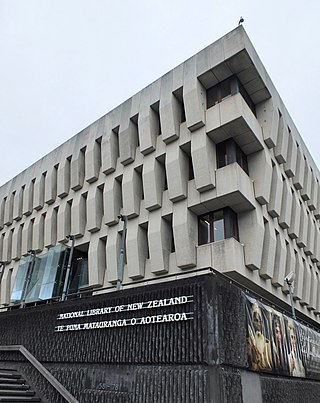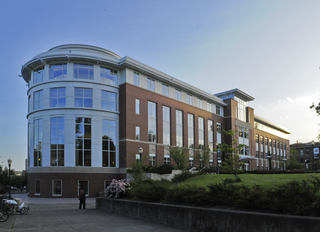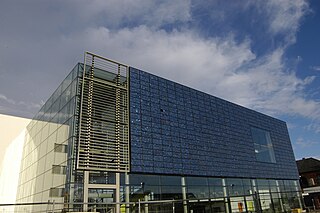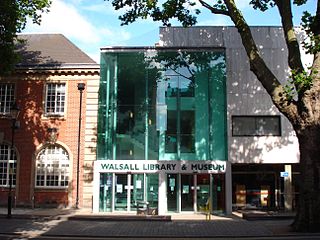
Cambridge University Library is the main research library of the University of Cambridge. It is the largest of over 100 libraries within the university. The library is a major scholarly resource for members of the University of Cambridge and external researchers. It is often referred to within the university as the UL. Thirty-three faculty and departmental libraries are associated with the University Library for the purpose of central governance and administration, forming "Cambridge University Libraries".

Birmingham Central Library was the main public library in Birmingham, England, from 1974 until 2013, replacing a library opened in 1865 and rebuilt in 1882. For a time the largest non-national library in Europe, it closed on 29 June 2013 and was replaced by the Library of Birmingham. The building was demolished in 2016, after 41 years, as part of the redevelopment of Paradise Circus by Argent Group. Designed by architect John Madin in the brutalist style, the library was part of an ambitious development project by Birmingham City Council to create a civic centre on its new Inner Ring Road system; however, for economic reasons significant parts of the master plan were not completed, and quality was reduced on materials as an economic measure. Two previous libraries occupied the adjacent site before Madin's library opened in 1974. The previous library, designed by John Henry Chamberlain, opened in 1883 and featured a tall clerestoried reading room. It was demolished in 1974 after the new library had opened.

The National Library of New Zealand is charged with the obligation to "enrich the cultural and economic life of New Zealand and its interchanges with other nations". Under the Act, the library's duties include collecting, preserving and protecting New Zealand's documentary heritage, supporting other libraries in New Zealand, and collaborating with peer institutions abroad. The library headquarters is on the corner of Aitken and Molesworth Streets in Wellington, close to the New Zealand Parliament Buildings and the Court of Appeal.

State Library Victoria (SLV) is the state library of Victoria, Australia. Located in Melbourne, it was established in 1854 as the Melbourne Public Library, making it Australia's oldest public library and one of the first free libraries in the world. It is also Australia's busiest public library and, as of 2023, the third busiest library globally.

The Chicago Public Library (CPL) is the public library system that serves the City of Chicago in the U.S. state of Illinois. It consists of 81 locations, including a central library, two regional libraries, and branches distributed throughout the city's 77 Community Areas.

Manchester Central Library is the headquarters of the city's library and information service in Manchester, England. Facing St Peter's Square, it was designed by E. Vincent Harris and constructed between 1930 and 1934. The form of the building, a columned portico attached to a rotunda domed structure, is loosely derived from the Pantheon, Rome. At its opening, one critic wrote, "This is the sort of thing which persuades one to believe in the perennial applicability of the Classical canon".
The National Library for the Blind (NLB) was a public library in the United Kingdom, founded 1882, which aimed to ensure that people with sight problems have the same access to library services as sighted people. NLB was taken over by the Royal National Institute of Blind People on 1 January 2007 and incorporated into the RNIB National Library Service.

The Johannesburg Zoo or Joburg Zoo is a 55-hectare (140-acre) zoo in Johannesburg, South Africa. The zoo is dedicated to the accommodation, enrichment, husbandry, and medical care of wild animals, and houses about 2000 individuals of 320 species. Established in 1904, it has traditionally been owned and operated by the Johannesburg City Council. However, it has been turned into a corporation and registered as a Section 21 non-profit organisation.

The Mitchell Library is a large public library located in the Charing Cross area of Glasgow, Scotland. It is the largest public reference library in Europe, and the centre of Glasgow's public library system.

The Valley Library is the primary library of Oregon State University and is located at the school's main campus in Corvallis in the U.S. state of Oregon. Established in 1887, the library was placed in its own building for the first time in 1918, what is now Kidder Hall. The current building opened in 1963 as the William Jasper Kerr Library and was expanded and renamed in 1999 as The Valley Library. The library is named for philanthropist F. Wayne Valley, who played football for Oregon State.

The Harris Museum is a Grade I-listed building in Preston, Lancashire, England. Founded by Edmund Harris in 1877, it is a local history and fine art museum.

There are 24 public libraries in Manchester, England, including the famous Central Library in St Peter’s Square.

Dunedin Public Libraries is a network of six libraries and two bookbuses in Dunedin, New Zealand, owned and operated by the Dunedin City Council. The Libraries' collection includes over 700,000 items, and around 30,000 books and audiovisual items plus 15,000 magazines are added each year. Members can borrow or return items from any library or bookbus in the network.

Christchurch City Libraries is a network of 21 libraries and a mobile book bus. operated by the Christchurch City Council and Following the 2011 Christchurch earthquake the previous Christchurch Central Library building was demolished, and was replaced by a new central library building in Cathedral Square, Tūranga, which opened in 2018. A number of community libraries were also rebuilt post earthquake.

The Museum of Wigan Life is a public museum and local history resource centre in Wigan, Greater Manchester, England. The nineteenth-century listed building is by the noted architect Alfred Waterhouse. It originally housed Wigan Library, where George Orwell researched his book The Road to Wigan Pier in 1936.

Walsall Central Library is a public library situated in the town centre of Walsall in the West Midlands, in the United Kingdom. It is part of 7 branch libraries and a mobile library service, and was officially opened to the public in 1906. The Central Library comprises a lending library, reference library, learning centre and children's library. It holds information in various formats and languages: books, journals, newspapers and magazines, and there are computer facilities available.

The Kerk Street Mosque, also known as the Jumah Mosque, is located in Johannesburg, South Africa.

Joburg Theatre Complex, previously known as the Johannesburg Civic Theatre, is a group of four theatres situated in Braamfontein, Johannesburg, South Africa. It was built in 1962, refurnished in the late 1980s and reopened in the early 1990s before it was re-branded in 2009. It's a venue to stage both Broadway musicals and home grown productions. It is one of the few theatres open in Johannesburg for independent productions.

Ljungby library, is a library in Ljungby, Sweden, that opened in 1982. It was designed by architect Jan Wallinder and have an interior designed by Rolf and Margareta Åberg. It is visited daily by 500 to 800 patrons and is 3,030 square metres (32,600 sq ft) in size. The library also house a small café plus an attached art gallery, which also can serve as lecture hall.

Belgrade City Library is a public library in Belgrade, the capital of Serbia. It is a parent library for more than a dozen municipal libraries and their branches. It is also the largest lending library in Serbia. It is located in the center of the city, in the pedestrian zone of Knez Mihailova Street, next to the shopping mall.






















